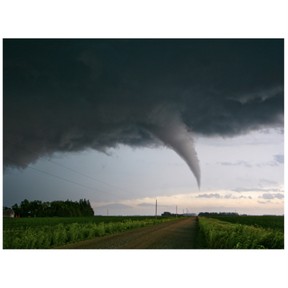
Tornadoes
I can describe a tornado and explain how to stay safe during a tornado.



8,000 schools use Gynzy
92,000 teachers use Gynzy
1,600,000 students use Gynzy
General
Students learn about tornadoes and how to prepare for a tornado. They'll learn what to do before a tornado hits, during a tornado, and after.
Standards
3-ESS3-1
4-ESS2-1
5-ESS2-1
Learning objective
Students will be able to describe a tornado and explain how to prepare for a tornado.
Introduction
Students are asked to turn and talk to a partner about the worst storm they have ever experienced. Where were they? How did they feel? What were they doing when the storm hit? Introduce the term tornado and explain that they are spinning columns of air that form when warm, wet air crashes into cold, dry air and touches the ground. Tell students that by learning about tornadoes, they can learn to be prepared when they do occur. Watch the video presented in the lesson to give a visual representation of different tornadoes and then answer the questions based on the video.
Instruction
Discuss the 'who' and 'where' of tornadoes followed by the 'how' and 'when.' Define who studies tornadoes and where tornadoes occur, mostly in the United States, though many countries in the world have reported tornadoes. Tell about "Tornado Alley" but mention that tornadoes have happened in all 50 states! Next, discuss what to do if you find yourself in a tornado by telling students what to do before, during, and after a tornado. Before a tornado, tell students that the best preparation is to be aware of the weather daily and to keep the yard clean. They should also know information about tornadoes and expect the power to go out. If they do get into a tornado- the tips for during a tornado are to get off the road and to protect your head. You can get to the lowest level of your home and stay away from windows. Then be sure to check the weather channel. Sometimes more than one tornado comes and you don't want to get caught outdoors! After the tornado, students should see what needs to be fixed. Have students fill in the blanks with words from the word bank. Then ask students to draw a line between an action and whether it should be done before, during, or after a tornado. Ask students to drag the statements to the boxes before, during, and after for tornado preparedness. As a class, read the paragraph about Jake and discuss what Jake can do before, during, and after a tornado to be better prepared.
Quiz
Students are asked true/false questions about key information given in the lesson. They are then asked to determine what they should do before, during, or after a tornado and given multiple-choice questions about the content.
Closing
Discuss the learning goal with students and check to see if they can identify a tornado and determine what to do to survive a tornado. Close the lesson by having students create a tornado preparedness plan. Students can use a graphic organizer in which they plan what to do before, during, and after a tornado.
Teaching tips
If you live in a location that has had a tornado, you may choose to incorporate that into your lesson. Include locations or areas that students are familiar with that were hit. Since some students are very scared of natural hazards, make sure to inform them that by following the steps given and that by being prepared, they increase their survival in these situations.
The online teaching platform for interactive whiteboards and displays in schools
Save time building lessons
Manage the classroom more efficiently
Increase student engagement
Discover more!
About Gynzy
Gynzy is an online teaching platform for interactive whiteboards and displays in schools.
With a focus on elementary education, Gynzy’s Whiteboard, digital tools, and activities make it easy for teachers to save time building lessons, increase student engagement, and make classroom management more efficient.



